by Winding Pathways | Feb 3, 2022 | Birds, Garden/Yard, Nature, Uncategorized
Millions of families love watching chickadees, nuthatches and woodpeckers visit backyard feeders. A joyful daily task is bringing them a day’s supply of sunflower seeds, millet, or even cracked corn. But, often an important part of their diet is ignored.
Birds lack teeth so never need dental care. Instead, they must eat rocks! Small rocks humans call sand. Often birds forage along snowy roads gleaning grit spread to give cars traction. It goes into their gizzard where powerful muscles grind seeds into a digestible slurry that then moves on to the stomach.
During most of the year, birds find all the grit they need on their own, but when snow and ice seal off the soil they can’t find it. People sometimes scatter sand on slippery spots to provide human traction. Birds will glean some of it.
It’s helpful to sprinkle a handful of sand around feeders once a week during the snowy season. At Winding Pathways, we buy a 50-pound bag of chick grit at a local store that sells chicken feed. It’s fine ground hard rock that is ideal for both traction and bird digestion but plain old sand works.
Wild Turkeys often visit our feeders, so once in a while, we toss out large-sized grit, designed for laying hens. It helps their gizzards grind up hard corn kernels that they love snacking on.
An outstanding source of bird information is the Cornell University Laboratory of Ornithology.
-
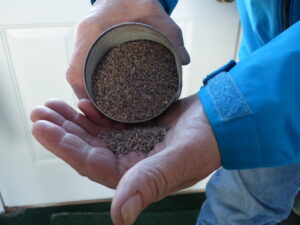
-
Chick grit is small.
-
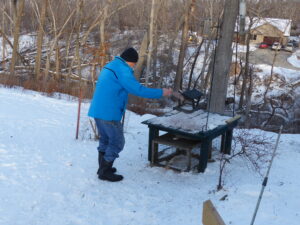
-
Sprinkle grit once a week to help birds in the snowy season.
-
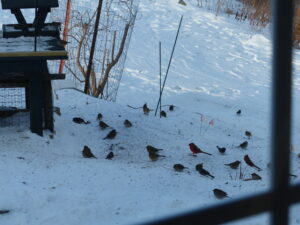
-
Birds flock to the seeds.
by Winding Pathways | Jan 6, 2022 | Birds, Nature, Pests
Artful Dodgers
Walking one of Cedar Rapids’ trails sometimes is like a skier racing a slalom course. Instead of weaving between flags, pedestrians must dodge piles of goose poop.
It wasn’t always that way. Before the mid-1980s few geese lived in town. Cedar Rapids began restoring them. About 125 of the giant birds were released near downtown. Few predators pester them and are they prolific! A goose couple can live for decades and raise upwards of a dozen goslings a year. That is a lot of geese!
Geese Mixed Blessing
Canada geese are a blessing. We love hearing “goose music” as they wing over our house. Watching such attentive parents teach their babies to swim and find food is great fun.
Canada geese are a curse, mostly because there are so many of them and they enjoy living, and pooping, in town. Their droppings are more than a walking nuisance. Loaded with nitrates and bacteria, they stimulate algae growth, lowering water quality.
-
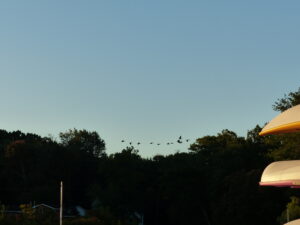
-
We enjoy the haunting call of geese on the wing.
-
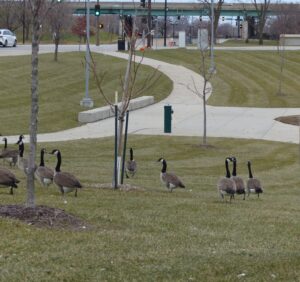
-
Geese love short grass
Geese Requirements
Geese love water but don’t need massive remote lakes. They prefer the dozens of small ponds at golf courses, corporate and school campuses, and parks. A lawnmower is a goose’s best friend. Well, maybe not a mower, but close-cropped lawns have tiny tender grass shoots that make fine goose dining. Running a mower down to a pond’s edge creates goose paradise. And problems for landowners.
People sometimes put snarling coyote mannequins near their pond to scare the big birds. It might work for a minute or two, but geese are smart. They figure out it’s a fake and nibble tender grass right under the phony predator.
How to Discourage Geese
Some cities reduce goose numbers by locating their nests, shaking the eggs to kill the embryos, which is called addling, or coating the eggs with oil so they won’t hatch. It may work to reduce flock size, but geese are protected by federal and state laws. Destroying eggs without a permit is illegal.
Legal Tricks
Here are less lethal and legal tricks that work, at least to some degree to discourage geese:
- Hold the chow. Folks love tossing stale bread to waterfowl, but it just encourages the crowding of the pesky birds.
- Stow the mower and let the grass grow. Geese shun tall grass. Even better, plant tall prairie grasses near the water’s edge.
- Fence ‘em out. For some reason geese don’t usually cross even small low barriers they could hop or fly over. A fence of lightweight plastic pipe set parallel to the edge of the water may discourage them from entering small areas.
We’ve got them. Geese are fellow city residents. We need to coexist, but a few simple tricks can discourage them from certain areas while still letting us enjoy delightful goose music as they wing overhead.
by Winding Pathways | Nov 11, 2021 | (Sub)Urban Homesteading, Birds, Garden/Yard, Nature
“A woodpecker is hammering on my house. It’s damaging my siding and driving me nuts. What can I do?” asked a longtime friend.
Woodpeckers often hammer on buildings, and we’ve taken dozens of calls from homeowners seeking relief. There are ways to discourage the plucky birds.
Woodpeckers bang on wood for at least three reasons:
- Drumming. Drumming on wood or metal in a rapid burst announces the bird’s presence to others. It is loud advertising.
- Nesting. Woodpeckers excavate cavities, usually in dead trees, to make a safe comfortable nest in the spring. A snug nest within an insulated wall is a great substitute for a tree.
- Food. Woodpeckers make their living dining on insects lurking in wood. Commonly this is a fall and winter activity, especially on home sided with rustic
T 111 plywood.
We love woodpeckers, and so do most people. But, no one wants damage to their home. So, how can it be prevented?
Prevention
It’s tough to stop drumming, but the good news is that it is usually of short duration in the spring and rarely damages the home.
It is difficult to stop birds from excavating a nest, but fortunately this is relatively rare. The long-term solution is to side the home with a durable hard material. Bricks are ideal.
Foraging may be the most common home damage. It can be extensive and comes with annoying noise as the bird removes wood to expose hidden bugs. Here are some solutions:
If building a new home, specify siding that lacks holes and cracks. If no insects can enter woodpeckers have no reason to try to extract them.
- With a caulking gun and putty knife plug every possible hole in the home’s exterior in late winter or early spring. This prevents insects from entering.
- If a woodpecker is foraging on a small section of the house draping light duty netting, the material sold to keep birds off cherry trees, will physically keep the birds away. Sometimes it can be stapled to an overhanging eve and to the siding below.
- Luring a bird away from the home may work. Erect a suet feeder 40 or 50 feet away from the house. The woodpecker might prefer eating easy-to-get suet instead of digging bugs out of the home.
-
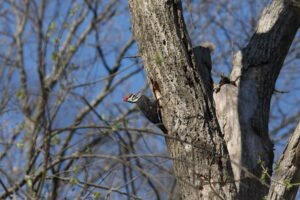
-
The Pileated woodpecker – Woody Woodpecker – is a sight to see!
-
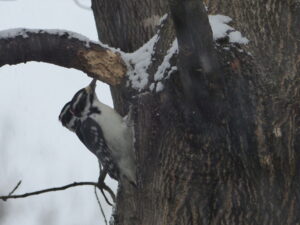
-
Woodpeckers dig for insects on trees.
-
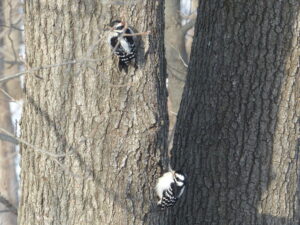
-
These woodpeckers are happy to forage for insects on a tree trunk.
Perhaps the best strategy for enjoying woodpeckers but preventing damage is to protect nearby dead trees. If a tree poses no falling threat to a structure, car, or person, leaving it in place gives woodpeckers a place to drum, nest, and find tasty insect meals.
Woodpeckers are amazing and beautiful animals that bring us joy. We are fortunate to have hairy, downy, red-bellied, red-headed, pileated, flicker, and sapsucker at Winding Pathways. They enjoy our feeders and leave the house alone.
-
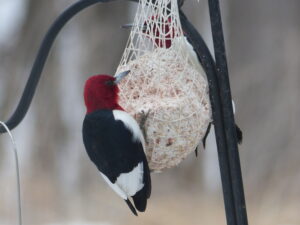
-
Woodpeckers would rather eat from a suet ball than drill on a house.
-
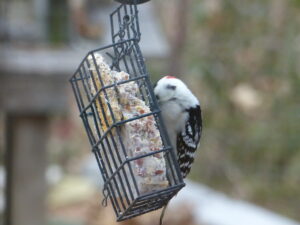
-
We’ve had all sorts of interesting woodpeckers at the feeders.
-
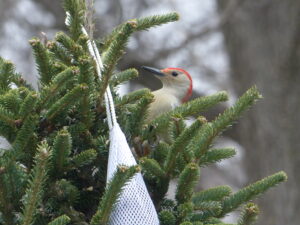
-
We tuck suet in Evergreen trees for the birds to enjoy.
by Winding Pathways | Nov 4, 2021 | Birds, Nature
What is a Bird Diva?
We’d only walked a short way when Bridget Butler stopped our small group. “Look at the top of that tree. See the bird,” she asked.
We did, and from long experience knew its species, but Bridget’s coaching helped us become better birders.
“Notice its size. Is it bigger/smaller than a sparrow”? (Bigger). Colors? (reddish/brownish).
Bridget was teaching us her method of slow birding. It’s an effective way to spot birds and figure out the species.
Slow Birding
We were in Vermont to attend the conference of the Outdoor Writer’s Association of America at Jay Peak ski resort tucked up near Canada. The Peak’s ashes, maples, and aspens were in glorious full color on the early October morning. Up early, we had met Bridget and other conference attendees in the hotel lobby.
Bridget slowly led us just past the parking lot, eyes and ears open for the slightest movement or chirp. We spotted and heard birds that a hasty walk would have bypassed.
What to Look and Listen For
Bridget’s suggestions for identifying a bird include:
Listen carefully. Often, it’s easier to distinguish a species by sound rather than sight. Close your eyes to help focus on sound.
Observe size. Compare the bird to common, landmark species. Is the bird bigger /smaller than a sparrow or robin or crow, for example?
Observe color/Patterns. Where is the most color on the bird? Are there eyelines, streaking on the breast?
Observe activity. Is the bird perched high in a tree or scurrying around in bushes? Is it solitary or in a flock?
Observe the habitat. Coniferous woods, hardwood forest, brush, grassy, marsh.
The bird we first spotted high in a spruce tree was a common American Robin, one of the most visible and recognizable of all birds. It provided Bridget with an example of how to help birding newcomers to learn species. And, was a reminder to experienced birders to slow down and observe more and be concerned less with adding to “the list.”
Various Habitats
Our walk took us from a mowed lawn through a dense sugar maple wood and around to a delightful pond at Jay Peak’s base. While in the woods a barred owl responded to Bridget’s call.
When we emerged from the woods to the open pond, we spotted a knot of ducks swimming on the far end. “Let’s walk slowly and see how close we can get,” she said. She suggested we avoid looking directly at the ducks – pretending that we didn’t know they were there. It worked! The ducks seemed unconcerned about our slow pace toward them yet instantly took flight when a jogger appeared on the other side of the pond.
Ring-Billed ducks! A thrilling sight as the colorful and agile birds winged against the backdrop of Jay Peak’s autumn splendor.
-
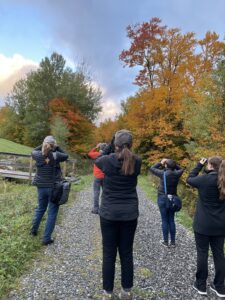
-
Pause to listen and look. Binoculars help.
-
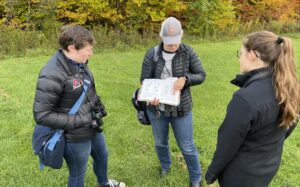
-
Bridget sharing identification tips with birders.
-
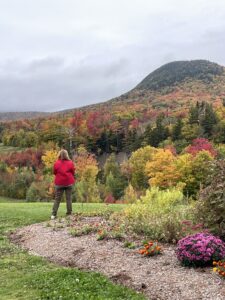
-
Varied elevations and habitats offered excellent birding.
Anyone heading for Vermont might want to join one of Bridget’s walks. If not, her slow birding technique works well anywhere. Her business is called Bird Diva Consulting. She leads bird walks, inventories birds, provides landowner assistance, and does presentations. Her website is birddiva.com.
by Winding Pathways | Sep 2, 2021 | (Sub)Urban Homesteading, Birds, Nature
A flurry of movement caught our attention. Just outside the dining room window, a tiny scrap of a bird flitted around. It wasn’t a wren, goldfinch, or sparrow. They’re around all year. Just what was it?
For most birders, May is the month to live for. Orioles, grosbeaks, tanagers, and warblers arrive as if by magic. They’re colorful, sing with gusto, and are easy to spot. It’s an exciting time, but it’s not THE ONLY exciting time.
All the colorful migrating May birds en route to northern nesting sites and the ones that stick around to nest locally are now heading south to avoid winter’s harshness. September is an outstanding birding month, but it’s also challenging.
September Birding
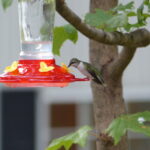
Birds stock up on high-calorie foods before their long migrations.
The birds are there but easy to miss. Many have gone through a late summer molt. They’ve replaced gaudy spring feathers with drab ones that enable them to hide better. September is a business month for birds. In May they happily court mates, but four months later the priority is beefing up their bodies for the long flight south. They dart about, often out of sight, seeking tasty insects, spiders, and seeds to fuel migration.
September birding takes patience. We find the most effective way to see birds is to sit quietly and watch. While we may slowly walk trails spotting birds in May, by September we sit on our deck in comfortable chairs, binoculars handy, and bird books and apps at the ready. We don’t find the birds. They find us, but because they don’t sing much and often look different than in Spring, identification is challenging.
Our backyard birding is exciting because we’ve diversified vegetation and have brushy areas, a prairie, a small pond, and big trees close by. However, we don’t just look there for birds. Sometimes we look upward to see soaring nighthawks, migrating raptors, and an occasional skein of Canada geese.
-
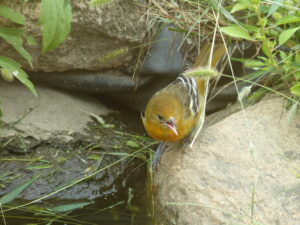
-
Birds stop for a drink and to fill up on the berries nearby.
-
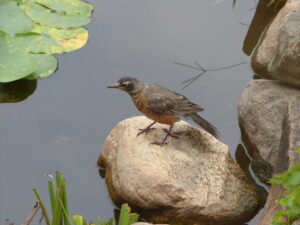
-
Keeping a wary eye, the robin cautiously gets a drink.
Identifying Fall Birds
To help with identification we use several printed bird books including the Peterson Guide and David Allen Sibley’s books. Increasingly we rely on Merlin. It’s an outstanding app produced by the Cornell University Laboratory of Ornithology. Even better, it’s free. The app easily helps identify species and shows many photos of every bird in spring/fall/juvenile/gender plumages. It also has range maps and recordings of the birds’ calls and songs. Merlin recently added a new function: sound identification. Point the phone at a singing bird and the app will help identify it by sound.
After we tentatively identify a bird, we try to confirm it by an Internet search and by consulting our birding friends. Our definitive online source is the Lab of Ornithology’s website. The site contains a vast amount of information, including how to access and use Merlin and eBird.
Easy to Keep Records
eBird allows us to record all bird species we spot in a day. Then we email results to the Lab for analysis. It’s great fun and helps the Lab research bird populations and movement.
There’s more to fall than football and leaf raking. It’s an excellent time to bird and the best birding is often the backyard.
by Winding Pathways | Jun 3, 2021 | Birds, Nature
Report from the Montessori School duck hatch: To review, the school saw a mallard sitting on an urban planter box. So, the staff and children made a project of watching the duck, noting its behavior, drawing pictures, and journaling about this experience. When the ducklings hatched the children, parents and staff followed the mother duck and ducklings on their way to new adventures.
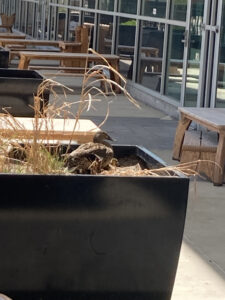
The Montessori children watched as the mallard duck sat on and hatched eggs
“The ducklings hatched last Sunday. On Monday, all 11 made it out of the planter and to the river. It was a bit traumatic. 10 fell into the storm drain and were brought out with a bug net by a parent.”
Some resources and thoughts:
The Wildlife Center of Virginia
Reconnect With Nature
Ducks Unlimited


















